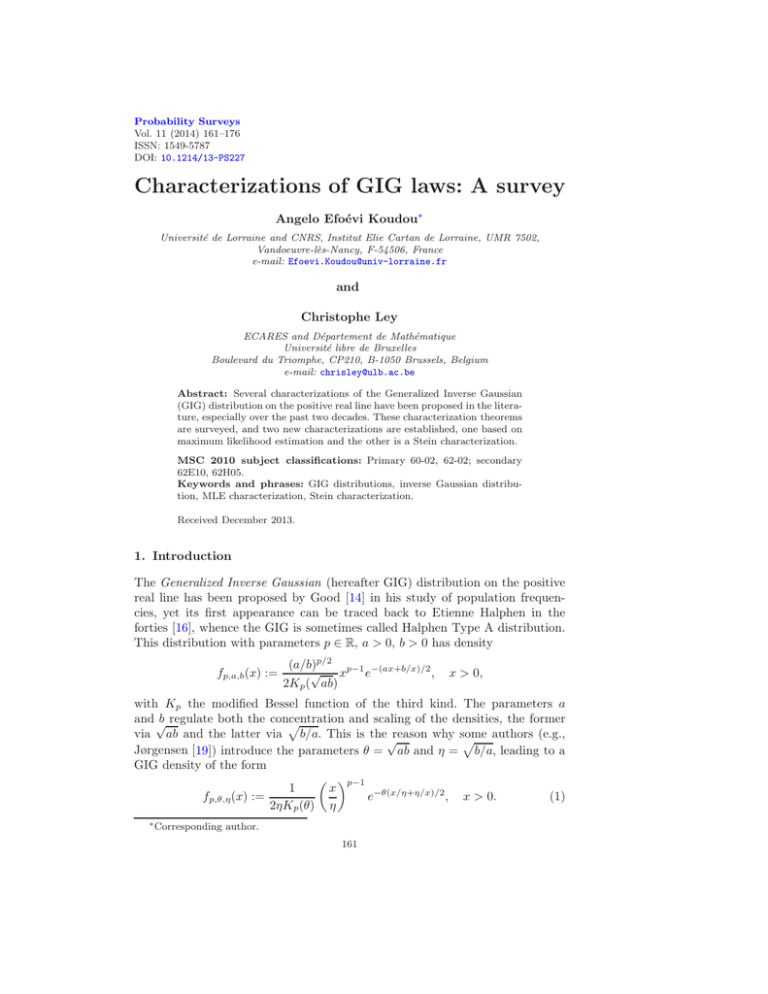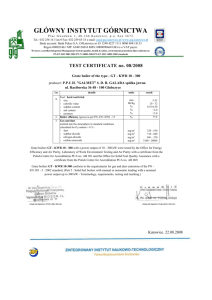Characterizations of GIG laws: A survey Angelo Efo´ evi Koudou
advertisement

Probability Surveys
Vol. 11 (2014) 161–176
ISSN: 1549-5787
DOI: 10.1214/13-PS227
Characterizations of GIG laws: A survey
Angelo Efoévi Koudou∗
Université de Lorraine and CNRS, Institut Elie Cartan de Lorraine, UMR 7502,
Vandoeuvre-lès-Nancy, F-54506, France
e-mail: Efoevi.Koudou@univ-lorraine.fr
and
Christophe Ley
ECARES and Département de Mathématique
Université libre de Bruxelles
Boulevard du Triomphe, CP210, B-1050 Brussels, Belgium
e-mail: chrisley@ulb.ac.be
Abstract: Several characterizations of the Generalized Inverse Gaussian
(GIG) distribution on the positive real line have been proposed in the literature, especially over the past two decades. These characterization theorems
are surveyed, and two new characterizations are established, one based on
maximum likelihood estimation and the other is a Stein characterization.
MSC 2010 subject classifications: Primary 60-02, 62-02; secondary
62E10, 62H05.
Keywords and phrases: GIG distributions, inverse Gaussian distribution, MLE characterization, Stein characterization.
Received December 2013.
1. Introduction
The Generalized Inverse Gaussian (hereafter GIG) distribution on the positive
real line has been proposed by Good [14] in his study of population frequencies, yet its first appearance can be traced back to Etienne Halphen in the
forties [16], whence the GIG is sometimes called Halphen Type A distribution.
This distribution with parameters p ∈ R, a > 0, b > 0 has density
fp,a,b (x) :=
(a/b)p/2 p−1 −(ax+b/x)/2
√ x e
,
2Kp ( ab)
x > 0,
with Kp the modified Bessel function of the third kind. The parameters a
and √
b regulate both the concentration
and scaling of the densities, the former
p
via ab and the latter via b/a. This is the√reason why some
p authors (e.g.,
Jørgensen [19]) introduce the parameters θ = ab and η = b/a, leading to a
GIG density of the form
p−1
x
1
e−θ(x/η+η/x)/2 , x > 0.
(1)
fp,θ,η (x) :=
2ηKp (θ) η
∗ Corresponding
author.
161
162
A.E. Koudou and C. Ley
The parameter p bears no concrete statistical meaning, but some particular values of p lead to well-known sub-models of the GIG such as the Inverse Gaussian
(p = − 21 ), the Reciprocal Inverse Gaussian (p = 21 ), the hyperbolic (p = 0,
in which case one also speaks of the Harmonic law), the positive hyperbolic
(p = 1), the Gamma (p > 0 and b = 0) or the Reciprocal Gamma distribution
(p < 0 and a = 0).
Several papers have investigated the probabilistic properties of the GIG distributions. For instance, Barndorff-Nielsen and Halgreen [1] have studied their convolution properties and established their infinite divisibility as well as interesting
properties such as the equivalence X ∼ GIG(p, a, b) ⇐⇒ X1 ∼ GIG(−p, b, a).
Vallois [59] has shown that, depending on the sign of p, the GIG laws can be
viewed as the distributions of either first or last exit times for certain diffusion
processes, generalizing the well-known fact that the Inverse Gaussian and Reciprocal Inverse Gaussian distributions are respectively the distributions of the
first and the last hitting time for a Brownian motion. Madan, Roynette and
Yor [36] have shown that the Black-Scholes formula in finance can be expressed
in terms of the distribution function of GIG variables. GIG distributions belong
to the family of generalized Γ-convolutions, as shown in Halgreen [15] (see also
Eberlein and Hammerstein [11] for a detailed proof). Sichel ([54], [55]) used
this distribution to construct mixtures of Poisson distributions.
The interesting properties of the GIG have led to the definition of matrix
GIG distributions, containing the special case of Wishart matrices for b = 0. In
this paper, we only deal with the one-dimensional GIG distribution. Since the
matrix case will sometimes be referred to in the course of this survey, let us recall
the definition of this distribution for matrix variates (see for instance Letac and
Wesolowski [31]). Let r ≥ 1 be an integer. Denote by Mr the Euclidean space of
r ×r real symmetric matrices. Consider the inner product ha, bi = tr(ab) on Mr .
+
Let M+
r be the cone of positive definite matrices in Mr . For p ∈ R, a, b ∈ Mr ,
the GIG distribution with parameters p, a, b is the probability measure on M+
r
whose density with respect to the Lebesgue measure on M+
r is proportional to
p− r+1
2
(det x)
1
−1
exp − (ha, xi + hb, x i) ,
2
x ∈ M+
r .
For an overview of results on matrix GIG laws, we refer the reader to Massam
and Wesolowski ([38], [39]). Throughout the paper, unless explicitly stated, the
name GIG distribution refers to the one-dimensional case r = 1.
The GIG distributions have been used in the modelization of diverse real
phenomena such as, for instance, waiting time (Jørgensen [19]), neural activity
(Iyengar and Liao [18]), or, most importantly, hydrologic extreme events (see
Chebana et al. [6] and references therein). Despite this popularity of GIG models, statistical aspects of the GIG distributions have received much less attention
in the literature than their probabilistic counterparts. The cornerstone reference
in this respect is Jørgensen [19], complemented by the stream of literature on
general Halphen distributions (of which the GIG or Halphen A is one of three
representatives), see e.g. Perreault et al. ([44], [45]) or Chebana et al. [6]. Quite
163
GIG characterizations
recently, Koudou and Ley [24] have applied the Le Cam methodology (see [27])
to GIG distributions in order to construct optimal (in the maximin sense) testing
procedures within the GIG family of distributions.
The present paper is concerned with characterization results of GIG laws.
In probability and statistics, a characterization theorem occurs when a given
distribution is the only one which satisfies a certain property. Besides their evident mathematical interest per se, characterization theorems also deepen our
understanding of the distributions under investigation and sometimes open unexpected paths to innovations which might have been uncovered otherwise. Over
the years, an important number of such characterization theorems for GIG laws
have been presented in the literature, especially over the past two decades. We
therefore propose here a survey of existing characterizations (without pretending to be exhaustive), amended by two novel characterizations, one based
on
p
the maximum likelihood estimator (MLE) of the scale parameter η = b/a of
GIG laws and the other is a so-called Stein characterization.
The paper is organized as follows. A review of known characterizations of
GIG distributions is presented in Section 2, while the short Section 3 is devoted
to our two new characterizations.
2. Known characterizations of GIG laws
2.1. A characterization by continued fractions
The following theorem characterizes the GIG distribution as the law of a continued fraction with independent Gamma entries. We adopt the notation Γ(p, a/2) =
GIG(p, a, 0) for the Gamma distribution with parameters p, a > 0 and =d for
equality in distribution.
Theorem 2.1 (Letac and Seshadri, [29]).
• Let X and Y be two independent random variables such that X > 0
1
if and only if X ∼
and Y ∼ Γ(p, a/2) for p, a > 0. Then X =d Y +X
GIG(−p, a, a).
• Let X, Y1 and Y2 be three independent random variables such that X > 0,
Y1 ∼ Γ(p, b/2) and Y2 ∼ Γ(p, a/2) for p, a, b > 0. Then X =d Y1 + 1 1 if
Y2 +X
and only if X ∼ GIG(−p, a, b).
• If (Yi )i≥1 is a sequence of independent random variables such that
L(Y2i−1 ) = L(Y1 ) = Γ(p, b/2) and L(Y2i ) = L(Y2 ) = Γ(p, a/2); i ≥ 1,
then the distribution of the random variable
1
Y2 +
is GIG(−p, a, b).
(2)
1
Y1 +
1
.
Y3 + . .
164
A.E. Koudou and C. Ley
The proof relies on properties of continued fractions, which are exploited
to show that the GIG distribution is the unique stationary distribution of the
Markov chain (Xm )m defined by
Xm+1 =
1
,
Ym+1 + Xm
in the case a = b, or by
Xm+1 =
1
Y2m+1 +
1
Y2m+2 +Xm
in the general case.
This characterization by continued fractions is one key ingredient in the proof
given by Letac and Wesolowski [31] of the characterization of GIG laws by the
Matsumoto-Yor property, which we now recall.
2.2. The Matsumoto-Yor property
Consider two independent, positive random variables X and Y such that
X ∼ GIG(−p, a, b), Y ∼ Γ(p, a/2)
for some p, a, b > 0. The Matsumoto-Yor property is the fact that the random
variables
1
1
1
and V =
−
(3)
U=
X +Y
X
X +Y
are independent. This property has been discovered in Matsumoto and Yor [40]
for the case a = b while studying certain exponential functionals of Brownian
motion. Letac and Wesolowski have noticed afterwards that this property remains true if a 6= b, although their paper has finally been published earlier than
the Matsumoto-Yor paper from 2001, namely in 2000. Letac and Wesolowski [31]
have further proved that this property is in fact a characterization of GIG laws
(more exactly, of the product of a GIG and a Gamma law with suitable parameters).
Theorem 2.2 (Letac and Wesolowski, [31]). Consider two non-Dirac, positive
and independent random variables X and Y . Then the random variables U =
(X + Y )−1 and V = X −1 − (X + Y )−1 are independent if and only if there exist
p > 0, a > 0 and b > 0 such that X ∼ GIG(−p, a, b) while Y ∼ Γ(p, a/2).
Let us make a few remarks on the theorem:
• As shown in the same paper, this result holds true also for matrix variates
(characterization of the product of matrix GIG and Wishart variables)
under a smoothness assumption not needed in the scalar case. To prove
this, the authors use the extension to the matrix case, established by
Bernadac [3], of the above mentioned continued-fraction characterization
of GIG distributions.
GIG characterizations
165
• An interpretation of this property in terms of Brownian motion has been
pointed out by Matsumoto and Yor [41]. Massam and Wesolowski [38]
have provided a tree-version of the Matsumoto-Yor property, and an interpretation of that tree-version by means of a family of Brownian motions
is given in Wesolowski and Witkowski [62].
• For p = −1/2, the Matsumoto-Yor property can be seen as a consequence of an independence property established by Barndorff-Nielsen and
Koudou [2] on a tree-network of Inverse Gaussian resistances (see
Koudou [23]).
• Koudou and Vallois ([25], [26]) investigated a generalization of the Matsumoto-Yor property, by looking for smooth decreasing functions f from
(0, ∞) onto (0, ∞) with the following property: there exist independent,
positive random variables X and Y such that the variables U = f (X + Y )
and V = f (X)−f (X +Y ) are independent. This led to other independence
properties of the Matsumoto-Yor type. In particular, an independence
property characterizing Kummer distributions has been established.
2.3. Characterizations by constant regression
In a subsequent work, Wesolowski [61] relaxed the independence condition between U and V in Theorem 2.2 by assuming that V and 1/V have constant regression on U . Following Lukacs [35], we say that a random variable Z with finite
expectation has a constant regression on a random variable T if E(Z|T ) = E(Z)
almost surely. As can be seen in the following theorems, the price to pay for the
relaxation at the level of independence is to assume the existence of moments
of X and/or 1/X.
Theorem 2.3 (Wesolowski [61]). Consider two non-Dirac, positive and independent random variables X and Y such that E(1/X) < ∞. Let U and V be
defined by (3), and assume that E(V |U ) = c and E(1/V |U ) = d for some real
constants c, d.
Then cd > 1 and there exists a > 0 such that X ∼ GIG(−p, 2a, 2b) and
Y ∼ Γ(p, a) where p = cd/(cd − 1) and b = d/(cd − 1).
One can prove that X is GIG distributed, assuming that Y is Gamma distributed, and vice-versa:
Theorem 2.4 (Seshadri and Wesolowski [51]). Consider two non-Dirac, positive and independent random variables X and Y such that E(1/X) and E(X) are
finite. Define U and V as in (3). Suppose Y ∼ Γ(p, a/2) for some p > 0, a > 0. If
the regression of V on U is constant, i.e. E(V |U ) = c, then X ∼ GIG(−p, a, b),
with b = 2p/c.
Theorem 2.5 (Seshadri and Wesolowski [51]). Consider two non-Dirac, positive and independent random variables X and Y such that E(Y ) < ∞. Assume that X ∼ GIG(−p, a, b) for some positive p, a, b. If E(V |U ) = 2p/b, then
Y ∼ Γ(p, a/2).
166
A.E. Koudou and C. Ley
Theorems 2.3, 2.4 and 2.5 are established by proving that Laplace transforms
of measures linked with the laws of X and Y are probabilistic solutions of secondorder differential equations. Wesolowski [61] has pointed out that the condition
E(V |U ) = c can be expressed in terms of linearity of the regression of Y /X on
X + Y , under the form
Y X
+
Y
= c(X + Y ).
E
X
This can easily be seen from the definition of U and V in (3).
The results of Wesolowski [61] and Seshadri and Wesolowski [51] have been
slightly extended in Chou and Huang [9].
Theorem 2.6 (Chou and Huang [9]). Consider two non-Dirac, positive and
independent random variables X and Y and define U and V as in (3). Assume
that, for some fixed integer r, E(X −r−2 ), E(X −r ), E(Y r ) and E(Y r+2 ) are
finite.
Assume that, for some constants cr and cr+1 ,
E(V r+1 | U ) = cr E(V r | U )
and
E(V r+2 | U ) = cr+1 E(V r+1 | U ).
Then, cr+1 > cr > 0 and there exists a > 0 such that X ∼ GIG(−p, 2a, 2b) and
Y ∼ Γ(p, a) with p = cr /(cr+1 − cr ) − r > 0 and b = 1/(cr+1 − cr ) > 0.
Lukacs [35] (Theorem 6.1) characterized the common normal distribution
of i.i.d. random variables X1 , X2 , . . . , Xn by the constancy
of regression of a
P
quadratic function of X1 , X2 , . . . , Xn on the sum Λ = ni=1 Xi . The following
theorem characterizing the GIG distribution belongs also to the family of characterizations of distributions by constancy of regression of a statistic S on the
sum Λ of observations.
Theorem 2.7 (Pusz [47]). Let X1 , X2 , . . . , Xn be independent and identically
distributed copies of a random variable X > 0 with E(1/X 2 ), E(1/X) and E(X)
finite.
q > 0 and p ∈ R such that pE(1/X) + qE(1/X 2) > 0 and define
PConsider
n
Λ = i=1 Xi and
!
n
n
n
X
X
X
1
1
1
+q
−
nq
.
S=Λ p
2
Xi
Xi
Xi
i=1
i=1
i=1
Then E(S|Λ) = c for some constant c if and only if there exist µ ∈ R, a, b, δ > 0
such that
p = δ(µ − 1), q = δb/2, c = δn(nµ − 1)
and X ∼ GIG(p, a, b).
The proof is based on the fact that the GIG distribution is characterized
by its moments, on a lemma by Kagan et al. [20] giving a necessary and sufficient condition for the constancy of E(S|Λ), and on a careful manipulation of a
differential equation satisfied by the function f (t) = E(1/X 2 ) exp(itX).
GIG characterizations
167
2.4. Entropy characterization
Characterizing a distribution by the maximum entropy principle dates back to
Shannon [53] who showed that Gaussian random variables maximize entropy
among all real-valued random variables with given mean and variance. Since
then, many examples of such characterizations have appeared in the literature.
For instance, Kagan et al. [20] characterized several well-known distributions
such as the exponential, Gamma or Beta distributions in terms of maximum
entropy given various constraints, e.g.: (i) the exponential distribution with
parameter λ maximizes the entropy among all the distributions of X supported
on the positive real line under the constraint E(X) = 1/λ; (ii) the Gamma
distribution Γ(p, a) maximizes the entropy under the constraints E(X) = p/a
and E(log X) = Ψ(p) − log a, where Ψ is the Digamma function; (iii) the Beta
distribution with parameters a, b > 0 maximizes the entropy among all the
distributions of X supported on [0, 1] under the constraints E(log X) = Ψ(a) −
Ψ(a + b) and E(log(1 − X)) = Ψ(b) − Ψ(a + b). This type of characterization
exists as well for GIG distributions, as established in the following theorem due
to Kawamura and Kōsei [22], for which we recall that the Bessel function of the
third kind is defined by
Z ∞
z2
−p−1 p
Kp (z) = 2
z
x−p−1 e−x− 4x dx, Re(z) > 0.
0
Theorem 2.8. The distribution of X with density f on (0, ∞) which maximizes
the entropy
Z ∞
f (x) log f (x) dx
H(X) = −
0
under the constraints
X
E log p
b/a
and
E
X
p
+
b/a
!
√
= ∂p log Kp ( ab)
!
p
√
√
b/a
Kp+1 ( ab) + Kp−1 ( ab)
√
=
X
Kp ( ab)
is the distribution GIG(p, a, b).
One application of entropy characterizations are goodness-of-fit tests. An
instance is Vasicek [60] who designed an entropy test of normality, using Shannon’s characterization. In our GIG setting, Mudholkar and Tian [42] established
a goodness-of-fit test for the special case of an Inverse Gaussian (IG) distribution
based on an entropy characterization that we recall below. Since the IG is a major particular case of GIG distributions —the latter were actually introduced in
order to meet the needs of adding a third parameter to the IG distribution—we
devote a brief subsection to characterizations of the IG distribution.
168
A.E. Koudou and C. Ley
2.5. Some characterizations of the IG distribution
Of particular interest for the present survey is the Inverse Gaussian distribution
with density
√
3
b √
√ e ab x− 2 e−(ax+b/x)/2 , x > 0.
2π
The IG distribution is useful in many fields for data modeling and analysis
when the observations are right-skewed. Numerous examples of applications
can be found in Chhikara and Folks [8], Seshadri [49] and Seshadri [50]. The IG
distribution possesses many similarities in terms of statistical properties with
the Gaussian distribution, as pointed out by e.g. Mudholkar and Tian [42]. We
give here a few results characterizing the IG distribution.
2.5.1. Entropy characterizations
Let us first observe that, as an immediate corollary of Theorem 2.8, we obtain
the following (new) entropy characterization of the IG distribution.
√
Theorem 2.9. Denote by ca,b the value of ∂p log Kp ( ab) at p = −1/2. The
distribution of X with density f on (0, ∞) having maximum entropy under the
constraints
!
!
p
b/a
1
X
X
=2+ √
= ca,b and E p
+
E log p
X
b/a
b/a
ab
is the distribution GIG(−1/2, a, b) = IG(a, b).
Mudholkar and Tian [42] have obtained another entropy characterization of
the IG distribution.
Theorem
2.10 (Mudholkar and Tian [42]).
A random variable X has the
p
√
IG( b/a, b) distribution if and only if 1/ X attains maximum entropy among
all absolutely continuous random variables Y ≥ 0 such that
p
p
E(Y −2 ) = b/a and E(Y 2 ) = a/b + 1/b.
Inspired by the Vasicek [60] methodology for the entropy test of normality,
Mudholkar and Tian [42], as stated earlier, used the above theorem to construct
a goodness-of-fit test for the IG distribution. The
√ test statistic is based on a
non-parametric estimation of the entropy of 1/ X and rejection occurs when
this estimation is not close enough to the theoretical value under the null hypothesis of X being IG-distributed. The rejection criterion is assessed at given
significance level by critical values obtained via Monte Carlo simulations.
2.5.2. A martingale characterization
Seshadri and Wesolowski [52] established the following martingale characterization of the IG distribution.
GIG characterizations
169
Theorem 2.11 (Seshadri and Wesolowski [52]). Let (Xn )n≥1 be a sequence
of positive, non degenerate i.i.d. random variables. For n ≥ 1, define Sn =
X1 + X2 + · · · + Xn and consider the σ-algebra Fn = σ(Sn , Sn+1 , . . .). Let b > 0.
The sequence
1
n
−
, Fn
Sn
2bn
n≥1
is a backward martingale if and only if X1 ∼ IG(a, b) for some a > 0.
Remark. In fact, the result established in Seshadri and Wesolowski [52] is more
general than stated in Theorem 2.11. They proved that ( αSnn − βn , Fn )n≥1 is
a backward martingale for some sequences (αn )n and (βn )n if and only if X1
follows one of four distributions, among which the IG distribution. The proof
uses the Letac and Mora [28] characterization of natural exponential families
with cubic variance function.
We conclude this section by writing down the well-known Khatri characterization of the IG distribution (see Letac and Seshadri [30] and also Seshadri [49]
which contains a review of characterization problems for the IG distribution).
Theorem 2.12 (Khatri [21]). Let X1 , X2 , . . . , Xn beP
i.i.d. copies of a random
n
variable X such that E(1/X), E(X), E(X 2 ) and E(1/ i=1 Xi ) exist and do not
vanish.
Let
n
n
1X 1
1X
Xi and X̄−1 =
.
X̄ =
n i=1
n i=1 Xi
The random variables X̄ and X̄−1 − 1/X̄ are independent if and only if there
exist a, b > 0 such that X ∼ IG(a, b).
p
If one considers the parameters µ = b/a and λ = b, then X̄ and 1/(X̄−1 −
1/X̄) are respectively the maximum likelihood estimators of µ and λ. The independence between these estimators characterizes the IG distribution, as the
independence between the empirical mean and standard deviation as maximum
likelihood estimators of location and scale characterizes the normal distribution. This is one of the similarities between the IG and normal distributions, as
observed by Mudholkar and Tian [42].
3. New characterizations of GIG laws
3.1. An MLE characterization
A famous characterization theorem in statistics due to Carl Friedrich Gauss [12]
says the following: the sample mean X̄ is for any i.i.d. sample X1 , . . . , Xn of
any sample size n the maximum likelihood estimator (MLE) of the location
parameter in a location family {f (x − µ), µ ∈ R} if and only if the samples
are drawn from a Gaussian population (with variance not fixed). This very
first MLE characterization theorem has important implications, as it clearly
170
A.E. Koudou and C. Ley
indicates that, the further one is away from the Gaussian situation, the less
efficient becomes the sample mean as estimator. Several other characterization
theorems have emerged in the past, linking particular forms of MLEs to a specific distribution such as the one-parameter exponential family (Poincaré [46]),
the (negative) exponential distribution (Teicher [58]), the Laplace distribution
(Kagan et al. [20]), the Gamma distribution (Marshall and Olkin [37]) or the
Harmonic Law (Hürlimann [17]). For a recent overview and a unified theory on
these results, we refer to Duerinckx et al. [10].
In this section, our aim is to apply the general result of Duerinckx et al. [10]
to the GIG distribution in order to construct an MLE characterization theorem
for GIG laws. To this end, we shall rather have recourse to the re-formulation (1)
of the density, as in that parameterization the family {fp,θ,η (x), η > 0} is a scale
family. Let us first observe, by a simple calculation, that the MLE of η for fixed
p and θ is
p
p2 + θ2 X̄ X̄−1 − p
η̂ =
,
θX̄−1
Pn
Pn
where we recall that X̄ = n1 i=1 Xi and X̄−1 = n1 i=1 X1i if X1 , . . . Xn are
i.i.d. with common distribution GIG(p, a, b). This enables us to formulate the
following.
√
p2 +θ 2 X̄ X̄−1 −p
Theorem 3.1. Consider an integer n ≥ 3. For p ∈ R and θ > 0,
θ X̄−1 o
n
is the MLE of the scale parameter η in a scale family η1 f (x/η), η > 0 on
(0, ∞) for all samples X1 , . . . , Xn of fixed sample size n if and only if there
exists d > 0 such that the family is {fpd,θd,η (x), η > 0}, i.e. the family of
densities of the distributions GIG(pd, θd/η, θηd), η > 0.
Proof of Theorem 3.1. We want to apply Theorem 5.1 of Duerinckx et al. [10].
To this end, we first need to calculate the scale score function of the standardized
1
GIG density fp,θ (x) := 2K1p (θ) xp−1 e− 2 θ(x+1/x) defined on (0, ∞). This score,
f′
(x)
p,θ
defined as ψfp,θ (x) = 1 + x fp,θ
(x) , corresponds to
θ
θ
ψfp,θ (x) = p − x +
.
2
2x
One easily sees that ψfp,θ is invertible over (0, ∞) with image R. Thus Theorem 5.1 of Duerinckx et al. [10] applies and the so-called MNSS (Minimal
Necessary Sample Size, the smallest sample size for which
√ an MLE characterp2 +θ 2 X̄ X̄
−p
−1
ization holds) equals 3. This theorem then yields that
is the
θ X̄
o−1
n
1
MLE of the scale parameter η in a scale family η f (x/η), η > 0 on (0, ∞) for
all samples X1 , . . . , Xn of fixed sample size n ≥ 3 if and only if the densities
are proportional to xd−1 (fp,θ (x))d for d > 0, which is nothing else but fpd,θd(x),
the (standardized) GIG density with parameters pd and θd. This yields the
announced MLE characterization for GIG laws.
171
GIG characterizations
Clearly, this MLE characterization theorem for GIG laws contains, inter
alia, MLE characterizations for the Inverse Gaussian, the Reciprocal Inverse
Gaussian and the hyperbolic or Harmonic Law, hence the characterization of
Hürlimann [17] is a special case of our Theorem 3.1.
3.2. A Stein characterization
The celebrated Stein’s method of normal approximation, introduced in Stein [56],
has over the years been adapted to several other probability distributions,
including the Poisson (Chen [7]), the exponential (Chatterjee et al. [5]), the
Gamma (Luk [34]), the multinomial (Loh [33]), the geometric (Peköz [43]), the
negative binomial (Brown and Phillips [4]) or the Beta (Goldstein and Reinert [13]). A first step in this method consists in finding a suitable Stein operator,
whose properties determine the quality of the approximation; see Ross [48] for
a recent overview on the intricacies of Stein’s method. This operator satisfies a
Stein characterization theorem which clearly links it to the targeted distribution.
To the best of the authors’ knowledge, so far no such Stein characterization
has been proposed in the literature for the GIG distribution, whence the reason
of the following result.
Theorem 3.2. A positive random variable X follows the GIG(p, a, b) distribution if and only if for any differentiable function h satisfying
lim fp,a,b (x)h(x) = lim fp,a,b (x)h(x) = 0
x→∞
we have
′
E h (X) +
x→0
a
b
p−1
−
+
X
2X 2
2
The functional h 7→ Tfp,a,b (h)(x) := h′ (x) +
Stein operator.
h(X) = 0.
p−1
x
+
b
2x2
−
a
2
(4)
h(x) is the GIG
Proof of Theorem 3.2. The sufficient condition is readily checked by noting that
(h(x)fp,a,b (x))′
b
a
, since then
h′ (x) + p−1
x + 2x2 − 2 h(x) =
fp,a,b (x)
′
E h (X) +
p−1
a
b
−
+
X
2X 2
2
Z
h(X) =
∞
(h(x)fp,a,b (x))′ dx = 0
0
by the conditions on h. To see the necessity, write f for the density of X and
define for z > 0 the function
lz (u) := I(0,z] (u) − Fp,a,b (z),
u > 0,
with Fp,a,b the GIG cumulative distribution function and I an indicator function.
Then the function
Z x
Z ∞
1
1
hz (x) :=
lz (u)fp,a,b (u)du = −
lz (u)fp,a,b (u)du
fp,a,b (x) 0
fp,a,b (x) x
172
A.E. Koudou and C. Ley
is differentiable and
R ∞ satisfies limx→∞ fp,a,b (x)hz (x) = limx→0 fp,a,b (x)hz (x) = 0
for all z (since 0 lz (u)fp,a,b (u) = 0), hence is a candidate function for the
functions h that verify (4). Using hence this hz leads to
a
b
p−1
′
hz (X)
−
+
0 = E hz (X) +
X
2X 2
2
(hz (X)fp,a,b (X))′
= E
fp,a,b (X)
Z ∞
=
lz (x)f (x)dx
0
= F (z) − Fp,a,b (z)
for every z > 0, from which we can conclude that F = Fp,a,b .
This result is a particular instance of the density approach to Stein characterizations initiated in Stein et al. [57] and further developed in Ley and Swan [32].
We attract the reader’s attention to the fact that we could replace the functions
h(x) with h(x)x2 , turning the GIG Stein operator Tfp,a,b (h) into the perhaps
more tractable form
a
b
Tfp,a,b (h)(x) = x2 h′ (x) + −x2 + (p + 1)x +
h(x).
2
2
This new Stein characterization and the associated Stein operator(s) could be
exploited to derive rates of convergence in some asymptotics related to GIG
distributions, e.g. the rate of convergence of the law of the continued fraction
in (2) to the GIG distribution. This kind of application will be investigated in
future work.
Acknowledgements
This research has been supported by Wallonie-Bruxelles International, the Fonds
de la Recherche Scientifique, the Ministère Français des Affaires étrangères et
européennes and the Ministère de l’Enseignement supérieur et de la Recherche as
part of the Hubert Curien 2013 Grant. Christophe Ley, who is also a member of
ECARES, thanks the Fonds National de la Recherche Scientifique, Communauté
Française de Belgique, for support via a Mandat de Chargé de Recherche FNRS.
The authors also thank an anonymous referee for helpful suggestions that led
to an improvement of the paper.
References
[1] Barndorff-Nielsen, O. E. and Halgreen, C. (1977). Infinite divisibility of the Hyperbolic and generalized inverse Gaussian distribution. Z.
Wahrsch. Verw. Geb. 38, 309–312. MR0436260
GIG characterizations
173
[2] Barndorff-Nielsen, O. E. and Koudou, A. E. (1998). Trees with random conductivities and the (reciprocal) inverse Gaussian distribution. Adv.
Appl. Probab. 30, 409–424. MR1642846
[3] Bernadac, E. (1995). Random continued fractions and inverse Gaussian distribution on a symmetric cone. J. Theor. Probab. 8, 221–260.
MR1325851
[4] Brown, T. and Phillips, M. (1999). Negative binomial approximation with Stein’s method. Methodol. Comput. Appl. Probab. 1, 407–421.
MR1770372
[5] Chatterjee, S., Fulman, S. and Röllin, A. (2011). Exponential approximation by Stein’s method and spectral graph theory. ALEA Lat. Am.
J. Probab. Math. Stat. 8, 197–223. MR2802856
[6] Chebana, F., El Adlouni, S. and Bobée, B. (2010). Mixed estimation
methods for Halphen distributions with applications in extreme hydrologic
events. Stoch. Environ. Res. Risk Assess. 24, 359–376.
[7] Chen, L. H. Y. (1975). Poisson approximation for dependent trials. Ann.
Probab. 3, 534–545.
[8] Chhikara, R. S. and Folks, J. L. (1989). The Inverse Gaussian Distribution, Theory, Methodology and Applications. Marcel Dekker Inc, New-York.
[9] Chou, C.-W. and Huang, J.-W. (2004). On characterizations of the
gamma and the generalized inverse Gaussian distributions. Stat. Probab.
Lett. 69, 381–388. MR2091757
[10] Duerinckx, M., Ley, C. and Swan, Y. (2013). Maximum likelihood
characterization of distributions. Bernoulli, to appear. MR3178518
[11] Eberlein, E. and Hammerstein, E. A. (2004). Generalized hyperbolic
and inverse Gaussian distributions: limiting cases and approximation of
processes. Prog. Probab. 58, 221–264. MR2096291
[12] Gauss, C. F. (1809). Theoria motus corporum coelestium in sectionibus
conicis solem ambientium. Cambridge Library Collection. Cambridge University Press, Cambridge. Reprint of the 1809 original. MR2858122
[13] Goldstein, L. and Reinert, G. (2013). Stein’s method for the Beta
distribution and the Pòlya-Eggenberger urn. Adv. Appl. Probab., to appear.
MR3161381
[14] Good, I. J. (1953). The population frequencies of species and the estimation of population parameters. Biometrika 40, 237–260. MR0061330
[15] Halgreen, C. (1979). Self-decomposability of the generalized inverse
Gaussian and hyperbolic distributions. Z. Wahrsch. verw. Geb. 47, 13–17.
MR0521527
[16] Halphen, E. (1941). Sur un nouveau type de courbe de fréquence. Comptes
Rendus de l’Académie des Sciences 213, 633–635. Published under the
name of “Dugué” due to war constraints. MR0009271
[17] Hürlimann, W. (1998). On the characterization of maximum likelihood
estimators for location-scale families. Comm. Statist. Theory Methods 27,
495–508. MR1621418
[18] Iyengar, S. and Liao, Q. (1997). Modeling neural activity using the
generalized inverse Gaussian distribution. Biol. Cybern. 77, 289–295.
174
A.E. Koudou and C. Ley
[19] Jørgensen, B. (1982). Statistical Properties of the Generalized Inverse
Gaussian Distribution. Springer-Verlag, Heidelberg. MR0648107
[20] Kagan, A. M., Linnik, Y. V. and Rao, C. R. (1973). Characterization
Problems in Mathematical Statistics. Wiley, New York. MR0346969
[21] Khatri, C. G. (1962). A characterisation of the inverse Gaussian distribution. Ann. Math. Statist. 33, 800–803. MR0137197
[22] Kawamura, T. and Kōsei, I. (2003). Characterisations of the distributions of power inverse Gaussian and others based on the entropy maximisation principle. J. Japan Statist. Soc. 33, 95–104. MR2044965
[23] Koudou, A. E. (2006). A link between the Matsumoto-Yor property and
an independence property on trees. Stat. Probab. Lett. 76, 1097–1101.
MR2269279
[24] Koudou, A. E. and Ley, C. (2014). Efficiency combined with simplicity:
new testing procedures for Generalized Inverse Gaussian models. Test, to
appear. DOI: 10.1007/s11749-014-0378-2.
[25] Koudou, A. E. and Vallois, P. (2011). Which distributions have
the Matsumoto-Yor property? Electron. Commun. Prob. 16, 556–566.
MR2836761
[26] Koudou, A. E. and Vallois, P. (2012). Independence properties of the
Matsumoto-Yor type. Bernoulli 18, 119–136. MR2888701
[27] Le Cam, L. and Yang, G. L. (2000). Asymptotics in statistics. Some
basic concepts. 2nd ed. Springer-Verlag, New York. MR1784901
[28] Letac, G. and Mora, M. (1990). Natural real exponential families with
cubic variance functions. Ann. Statist. 18, 1–37. MR1041384
[29] Letac, G. and Seshadri, V. (1983). A characterization of the generalized
inverse Gaussian distribution by continued fractions. Z. Wahrsch. Verw.
Geb. 62, 485–489. MR0690573
[30] Letac, G. and Seshadri, V. (1985). On Khatri’s characterization of the
inverse Gaussian distribution. Can. J. Stat. 13, 249–252. MR0818329
[31] Letac, G. and Wesolowski, J. (2000). An independence property for the
product of GIG and gamma laws. Ann. Probab. 28, 1371–1383. MR1797878
[32] Ley, C. and Swan, Y. (2013). Stein’s density approach and information
inequalities. Electron. Comm. Probab. 18, 1–14. MR3019670
[33] Loh, W. L. (1992). Stein’s method and multinomial approximation. Ann.
Appl. Probab. 2, 536–554. MR1177898
[34] Luk, H.-M. (1994). Stein’s method for the gamma distribution and related
statistical applications. Ph.D. thesis. University of Southern California. Los
Angeles, USA. MR2693204
[35] Lukacs, E. (1956). Characterization of populations by properties of suitable statistics. Proc. Third Berkeley Symp. on Math. Statist. and Prob.,
Vol. 2 (Univ. of Calif. Press), 195–214. MR0084892
[36] Madan, D., Roynette, B. and Yor, M. (2008). Unifying Black-Scholes
type formulae which involve Brownian last passage times up to a finite
horizon. Asia-Pacific Finan. Markets 15, 97–115.
[37] Marshall, A. W. and Olkin, I. (1993). Maximum likelihood characterizations of distributions. Statist. Sinica 3, 157–171. MR1219297
GIG characterizations
175
[38] Massam, H. and Wesolowski, J. (2004). The Matsumoto-Yor property
on trees. Bernoulli 10, 685–700. MR2076069
[39] Massam, H. and Wesolowski, J. (2006). The Matsumoto-Yor property
and the structure of the Wishart distribution. J. Multivariate Anal. 97,
103–123. MR2208845
[40] Matsumoto, H. and Yor, M. (2001). An analogue of Pitman’s 2M − X
theorem for exponential Wiener functional, Part II: the role of the generalized inverse Gaussian laws. Nagoya Math. J. 162, 65–86. MR1836133
[41] Matsumoto, H. and Yor, M. (2003). Interpretation via Brownian motion
of some independence properties between GIG and Gamma variables. Stat.
Probab. Lett. 61, 253–259. MR1959132
[42] Mudholkar, S. M. and Tian, L. (2002). An entropy characterization of
the inverse Gaussian distribution and related goodness-of-fit test. J. Stat.
Plan. Infer. 102, 211–221. MR1896483
[43] Peköz, E. (1996). Stein’s method for geometric approximation. J. Appl.
Probab. 33, 707–713. MR1401468
[44] Perreault, L., Bobée, B. and Rasmussen, P. F. (1999a). Halphen
distribution system. I: Mathematical and statistical properties. J. Hydrol.
Eng. 4, 189–199.
[45] Perreault, L., Bobée, B. and Rasmussen, P. F. (1999b). Halphen distribution system. II: Parameter and quantile estimation. J. Hydrol. Eng. 4,
200–208.
[46] Poincaré, H. (1912). Calcul des probabilités. Carré-Naud, Paris.
[47] Pusz, J. (1997). Regressional characterization of the Generalized inverse
Gaussian population. Ann. Inst. Statist. Math. 49, 315–319. MR1463309
[48] Ross, N. (2011). Fundamentals of Stein’s method. Probab. Surv. 8, 210–
293. MR2861132
[49] Seshadri, V. (1993). The Inverse Gaussian Distribution, a case study in
exponential families. Oxford Science Publications. MR1306281
[50] Seshadri, V. (1999). The Inverse Gaussian Distribution. Springer-Verlag,
New York. MR1622488
[51] Seshadri, V. and Wesolowski, J. (2001). Mutual characterizations of
the gamma and the generalized inverse Gaussian laws by constancy of regression. Sankhya Ser. A 63, 107–112. MR1898552
[52] Seshadri, V. and Wesolowski, J. (2004). Martingales defined by reciprocals of sums and related characterizations. Comm. Statist. Theory Methods 33, 2993–3007. MR2138669
[53] Shannon, C. E. (1949). The Mathematical Theory of Communication.
Wiley, New York.
[54] Sichel, H. S. (1974). On a distribution representing sentence-length in
written prose. J. R. Stat. Soc. Ser. A 137, 25–34.
[55] Sichel, H. S. (1975). On a distribution law for word frequencies. J. Am.
Stat. Assoc. 70, 542–547.
[56] Stein, C. (1972). A bound for the error in the normal approximation to
the distribution of a sum of dependent random variables. In Proceedings of
176
[57]
[58]
[59]
[60]
[61]
[62]
A.E. Koudou and C. Ley
the Sixth Berkeley Symposium on Mathematical Statistics and Probability
(Vol 2, pp. 586–602). Berkeley: University of California Press. MR0402873
Stein, C., Diaconis, P., Holmes, S. and Reinert, G. (2004). Use of
exchangeable pairs in the analysis of simulations. In Persi Diaconis and
Susan Holmes, editors, Stein’s method: expository lectures and applications,
volume 46 of IMS Lecture Notes Monogr. Ser, pages 1–26. Beachwood,
Ohio, USA: Institute of Mathematical Statistics. MR2118600
Teicher, H. (1961). Maximum likelihood characterization of distributions.
Ann. Math. Statist. 32, 1214–1222. MR0130726
Vallois, P. (1991). La loi Gaussienne inverse généralisée comme premier
ou dernier temps de passage de diffusion. Bull. Sc. Math., 2e Série, 115,
301–368. MR1117781
Vasicek, O. (1976). A test for normality based on sample entropy. J. R.
Stat. Soc. Ser. B 38, 54–59. MR0420958
Wesolowski, J. (2002). The Matsumoto-Yor independence property for
GIG and Gamma laws, revisited. Math. Proc. Camb. Philos. Soc. 133,
153–161. MR1888812
Wesolowski, J. and Witkowski, P. (2007). Hitting times of Brownian
motion and the Matsumoto-Yor property on trees. Stoch. Proc. Appl. 117,
1303–1315. MR2343941






